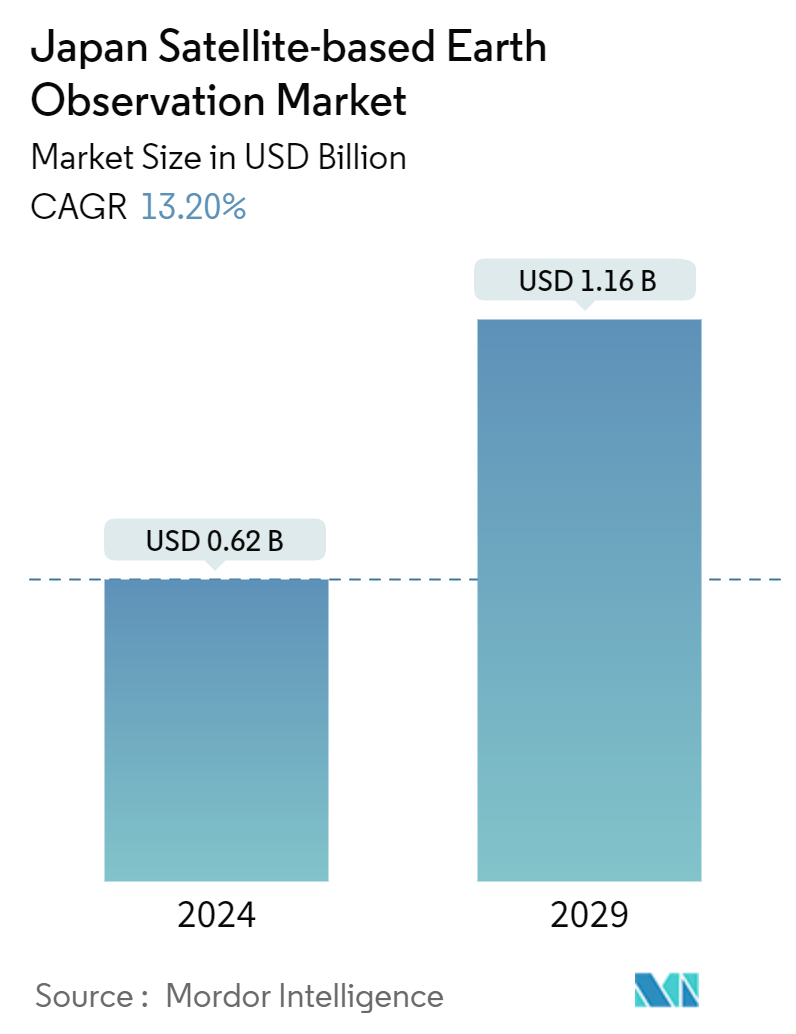Market Size of Japan Satellite-based Earth Observation Industry

| Study Period | 2019 - 2029 |
| Base Year For Estimation | 2023 |
| Market Size (2024) | USD 0.62 Billion |
| Market Size (2029) | USD 1.16 Billion |
| CAGR (2024 - 2029) | 13.20 % |
| Market Concentration | Low |
Major Players
*Disclaimer: Major Players sorted in no particular order |
Japan Satellite-based Earth Observation Market Analysis
The Japan Satellite-based Earth Observation Market size is estimated at USD 0.62 billion in 2024, and is expected to reach USD 1.16 billion by 2029, growing at a CAGR of 13.20% during the forecast period (2024-2029).
The continuous advancement of satellite technology, including higher-resolution imaging capabilities, improved data processing algorithms, and enhanced data transmission, is expected to drive the Earth observation market in Japan. These advancements enable better data acquisition, analysis, and interpretation for various applications.
- Satellite-based Earth observation is essential for Japan's disaster management, environmental monitoring, agriculture, infrastructure planning, fisheries management, climate research, national security, and scientific endeavors. By leveraging satellite technology and data, Japan can make informed decisions, enhance preparedness, and contribute to sustainable development.
- Government initiatives and investments primarily drive the market in Japan. The Japanese government has actively promoted the development of the space industry, recognizing the importance of satellite-based Earth observation for addressing critical challenges. Through policies, funding, and collaboration with public and private entities, the government has created a favorable ecosystem for market growth.
- One of the key drivers of the market is the need for effective disaster management. Japan is prone to natural disasters, including earthquakes, tsunamis, typhoons, and volcanic eruptions. Satellite-based Earth observation is crucial in monitoring and assessing these events, providing real-time data, early warning systems, and post-disaster analysis. The demand for accurate and timely information to enhance disaster preparedness and response drives the market in this segment.
- Another significant driver is the growing focus on environmental monitoring and climate change. Japan, as an island nation with diverse ecosystems, recognizes the importance of monitoring environmental parameters such as deforestation, urbanization, pollution, and the impact of climate change. Satellite-based Earth observation provides valuable data and insights for understanding and managing these environmental challenges. The increasing awareness of sustainability and the need for informed decision-making propel the demand for Earth observation solutions in this domain.
- Despite the government's support, budget constraints can limit the scale and pace of investment in satellite-based Earth observation initiatives. Allocating funds for satellite launches, infrastructure development, data processing, and research and development can be challenging, mainly when competing with other national priorities.
Japan Satellite-based Earth Observation Industry Segmentation
Satellite-based earth observation is done with the help of satellites orbiting around the planet to view and identify environmental changes, map making, etc. Satellite-based earth observation technology captures and stores information from satellites relating to the physical, biological, and chemical compositions of the earth for monitoring, surveillance, and decision-making in various verticals, such as defense and intelligence, infrastructure and engineering, natural resource management, energy and power, and disaster management.
The Japan satellite-based earth observation market is segmented by type (earth observation data, value-added services), satellite orbit (low earth orbit, medium earth orbit, geostationary orbit), and end-use (urban development and cultural heritage, agriculture, climate services, energy and raw materials, infrastructure). The market sizes and forecasts are provided in terms of value (USD billion) for all the above segments.
| By Type | |
| Earth Observation Data | |
| Value Added Services |
| By Satellite Orbit | |
| Low Earth Orbit | |
| Medium Earth Orbit | |
| Geostationary Orbit |
| By End-use | |
| Urban Development and Cultural Heritage | |
| Agriculture | |
| Climate Services | |
| Energy and Raw Materials | |
| Infrastructure | |
| Others |
Japan Satellite-based Earth Observation Market Size Summary
The Japan satellite-based earth observation market is poised for substantial growth, driven by advancements in satellite technology and the increasing demand for data-driven solutions across various sectors. The continuous improvement in imaging capabilities, data processing algorithms, and transmission methods is enhancing Japan's ability to acquire, analyze, and interpret data for applications such as disaster management, environmental monitoring, and urban planning. The government's proactive role in promoting the space industry through policies, funding, and public-private collaborations has created a conducive environment for market expansion. This support is particularly crucial in addressing Japan's unique challenges, such as natural disasters and environmental changes, by providing timely and accurate data for informed decision-making and sustainable development.
The market landscape in Japan is characterized by a diverse array of players, including government agencies, research institutions, and private companies, all contributing to the development and utilization of satellite-based earth observation technologies. Strategic partnerships and collaborations, both domestically and internationally, are fostering innovation and expanding the application of satellite data. Initiatives such as the establishment of satellite offices and collaborations with international entities like the European Union are enhancing Japan's capabilities in earth observation. These efforts are not only advancing technological development but also ensuring equitable access to satellite-based data and services, supporting urban planning, infrastructure development, and cultural heritage preservation in a rapidly urbanizing nation.
Japan Satellite-based Earth Observation Market Size - Table of Contents
-
1. MARKET INSIGHTS
-
1.1 Market Overview
-
1.2 Industry Attractiveness - Porter's Five Forces Analysis
-
1.2.1 Bargaining Power of Buyers
-
1.2.2 Bargaining Power of Suppliers
-
1.2.3 Threat of New Entrants
-
1.2.4 Threat of Substitutes
-
1.2.5 Intensity of Competitive Rivalry
-
-
1.3 Industry Value Chain Analysis
-
1.4 Assessment of the Impact of COVID-19 on the Market
-
-
2. MARKET SEGMENTATION
-
2.1 By Type
-
2.1.1 Earth Observation Data
-
2.1.2 Value Added Services
-
-
2.2 By Satellite Orbit
-
2.2.1 Low Earth Orbit
-
2.2.2 Medium Earth Orbit
-
2.2.3 Geostationary Orbit
-
-
2.3 By End-use
-
2.3.1 Urban Development and Cultural Heritage
-
2.3.2 Agriculture
-
2.3.3 Climate Services
-
2.3.4 Energy and Raw Materials
-
2.3.5 Infrastructure
-
2.3.6 Others
-
-
Japan Satellite-based Earth Observation Market Size FAQs
How big is the Japan Satellite-based Earth Observation Market?
The Japan Satellite-based Earth Observation Market size is expected to reach USD 0.62 billion in 2024 and grow at a CAGR of 13.20% to reach USD 1.16 billion by 2029.
What is the current Japan Satellite-based Earth Observation Market size?
In 2024, the Japan Satellite-based Earth Observation Market size is expected to reach USD 0.62 billion.

